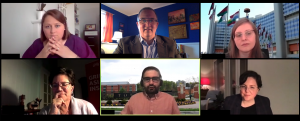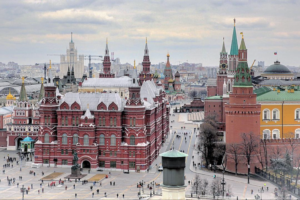ARTICLES
Promoting Glasnost & Perestroika: The US-USSR Information and Cultural Talks
By Michael Schneider, Syracuse University
March 26, 2018
Professor Michael Schneider of the Maxwell School of Public Administration at Syracuse University looks back on public diplomacy efforts in the age of Glasnost and Perestroika.
Between 1987 and 1990, a remarkable coalition of American leaders in government, the private sector, academe and non-profits spent time and effort to foster Glasnost and Perestroika.
Four rounds of bilateral talks were the brainchild of USIA Director Charles Z. Wick, close family friend of Ronald and Nancy Reagan and a successful Hollywood producer and businessman. Observing the progress of arms control negotiations, Mr. Wick saw need and opportunity for parallel talks in the realm of ideas. He was an inveterate deal-maker who energetically pursued achievements and appreciated creativity. Above all else, he was devoted to support the Reagans.
The talks took place both in Washington and Moscow and ran the gamut from ideology to exchanges to commercial arrangements by American private sector leaders with Soviet media and publishing officials. Mr. Wick and his successor Bruce Gelb engaged some 20-30 leaders from the U.S. each round to meet with Soviet “counterparts”. The match was not always parallel since in virtually all fields of communication, American private sector leaders met with Soviet officials. We divided our delegation into State-to-State and media panels – film, books, broadcasting, public relations, academic and market research. The institutional and ideological disparities were both significant and interesting, but didn’t impede the conversation.
A very talented and energetic staff of public diplomats in the U.S. embassy and a very supportive Ambassador, Jack Matlock, who “knew the territory” were critical intermediaries.
Thirty years ago, in September 1988, the most important, second round of Talks occurred in Moscow and coincided with President Reagan’s historic visit. A new cultural exchange agreement and other commitments heralded and a new era in relations.
The results of the several rounds of Talks more than justified the effort:
- The US and USSR updated and expanded the initial agreement on exchanges dating back to 1958.
- VOA gained the right to open a bureau, and RFE/RL, a Moscow-based stringer.
- On behalf of the MPAA/MPEA Jack Valenti signed a (short-lived) agreement with Soviet film counterparts for production cooperation and to eliminate piracy of American films. Although not observed, the agreement forced the Soviets to account publicly for their formal commitment. MPAA/MPEA also gained agreement to use rubles earned through commercial film showings for in-country productions.
- American market and survey researchers helped a budding Soviet profession develop. The first (big floppy) disks of SPSS, the key tool for social analysis were presented to Russian market and social researchers.
- Westwood One made a quick deal to place three popular music packages on Soviet radio.
- We were able to lift Soviet-imposed ceilings on the distribution of America Illustrated and Soviet Life, with market forces prevailing.
- A lot of intangibles resulted – contacts between American publishers and public relations leaders, newspaper editors, cultural leaders with Soviet leaders in diverse fields. Major American associations organized visits for Soviets and follow-up contacts.
- Notable American public relations leaders such as Hal Burson, co-founder of Burson-Marstellar, and John Paluszek, CEO of Ketchum, explained the fundamentals of market forces and consulting consumers.
- The US delegation called the Soviets down on their varied global disinformation activities, and on the lack of American media available to publics in the USSR and broadcast jamming.
The Talks created opportunities for Americans in various fields to reach out to Soviet counterparts:
- Spurred on by Senator Bill Bradley and Librarian of Congress James Billington, USIA developed the first high school exchanges with the USSR.
- Both sides opened opportunities for travel in the other country, formerly constricted by reciprocal travel restrictions
- Radio and Interactive TV “Spacebridges” took place on themes of national life and public health.
- Judicial exchanges dealt with numerous shared concerns, such as a video telebridge on Administrative law.
- The US translated and published in Russian a series of seminal books on American history, society and values
- The talks led the two sides even to share ideas on how to combat health issues from drugs and alcohol abuse
One unheralded detail demonstrated Mr. Wick’s deal-making propensity. For years, the USSR agencies involved with officially sponsored visitors from the U.S. (and other nations) took the U.S. sponsors to the cleaners by charging inflated costs for in-country expenses, with a highly disadvantageous dollar-to-ruble exchange rate, and often insisting on hard currency payment. Dollar payments for in-USSR travel expenses and the Intourist rate in the late 1980s were no better than $1.62 = one ruble.
The night before the Kremlin signing ceremony for the new exchange agreement, Mr. Wick insisted that he could not return to the U.S. with the official Soviet dollar/ruble rate.
This last-minute decision caused a frantic effort by the two delegations to come up with a new formula.
The U.S. paid the price of this change by losing a chance to open libraries in a number of locations in the USSR, and other opportunities we were eager to pursue. The Soviets agreed to a revised ruble/dollar rate for official exchanges which soon came to be six rubles to the dollar. This was a tiny chink in the armor, preceding the break-up of the USSR, Russia’s financial implosion in the 90s devaluation in the late 90s.
The talks might have added some more legitimacy to reform efforts by Gorbachev (counseled by Aleksandr Yakovlev.) A group of younger reformers emerged who promoted such changes as a new press law, the opening of independent local radio, cable and TV stations, greater archival access; and market research. These young and relatively polished Soviet staff with political and propaganda portfolios contributed to the achievements of the four sessions. And several ended up by moving to the U.S. to do “bizness”.
The Talks also revealed the stresses of reform in the USSR. In the fourth round in 1990, at one panel, the Soviet delegation broke into an intensely heated debate among its members. Somewhat befuddled we asked one of the young protagonists what the debate was all about, and he answered, “…. about a future constitution for Russia!”
In retrospect there were several historical “lessons learned” from the Talks:
- Basket III (on observance of human rights) of the 1975 Helsinki Accords were not a wasted effort, even tho skeptics in the West, and Soviet leaders didn’t believe much internal change in the USSR would occur. That earlier effort to set public standards and public accountability for internal governance, helped force Soviet leaders to at least pay lip-service to world opinion. The bilateral talks helped further this idea.
- Such high-profile exchanges can create a commitment by both parties to “deliverables” and drive the two sides toward cooperative goals and deadlines. In the 90s the Gore-Chernomyrdin Talks covered a wide array of contentions and mutual concerns. Annual high-level conferences have helped the US engage many major powers in past several decades.
- Some of the flashier agreements in 1988 did not find fulfillment, but even with shortcomings, the agreements set an agenda, raised the public profile of an issue – or an opportunity — and helped us return to the issue periodically as well as build international accountability.
- These events help our government representatives build ties with American leaders from business, NGOs and academe, and pursue mutual interests. Absent such cooperation, we lose impact abroad. Indeed, the strength of the U.S. abroad relies on the strength of the private sector.
- A visit to Novosti headquarters brought home this realization. Novosti officials showed a wall map of its global computer and broadcast systems, easily 15 x 30 feet. And we all knew of the size and scope of Soviet book publications, translations, and other representations of Soviet soft power. Nevertheless, all of this was a fraction of American publishing, broadcasting, film or other creative enterprises. In the digital era we have seen the impact of American media and communication capacities.
That was a heady, optimistic time in which we opened doors and some minds to what openness, political change and social reform could mean for their society. Perhaps we were over-optimistic, as the Putin era of retrenchment of rights is showing us. But the Information and Cultural Talks in their time contributed significantly to a new, post-Cold War era in bilateral relations, which was in the U.S. national interest and better than the past.

